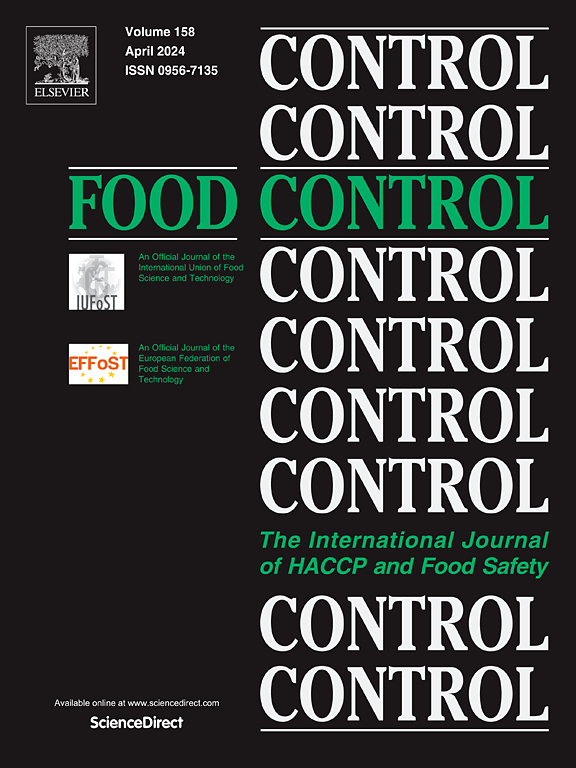消除食品接触表面李斯特菌生物膜的强化蒸汽消毒策略
IF 5.6
1区 农林科学
Q1 FOOD SCIENCE & TECHNOLOGY
引用次数: 0
摘要
被单核细胞增多性李斯特菌污染的食品加工设备是导致各种新鲜农产品爆发李斯特菌病的主要原因,因此需要采取有效的表面消毒策略来消除食品接触表面的这种病原体。本研究评估了在 100 至 142 ° C 温度范围内使用或不使用化学消毒剂进行蒸汽处理对不锈钢(SS)、聚酯(PET)和橡胶表面上的无毒李斯特菌(单核细胞增生李斯特菌的替代物)生物膜的效果。将这些表面上七天龄的无柄梭状芽孢杆菌生物膜单独或与 10 ppm 过氧乙酸 (PAA) 或季铵盐化合物 (QAC) 一起在 100、125 和 142 °C 下进行短时间蒸汽处理。然后分离并计数可培养的无毒梭菌细胞。结果表明,无论蒸汽温度或表面材料如何,蒸汽处理都能在启动时间(CUT,8-12 秒)内快速杀灭病原菌。例如,100-142 °C的蒸汽CUT可使可培养的无毒梭状芽孢杆菌在SS上减少3.0-4.2 log10 CFU/coupon,在PET上减少2.5-2.9 log10 CFU/coupon,在橡胶上减少2.4-2.8 log10 CFU/coupon。然而,杀灭率在超过切口和延长蒸汽暴露时间后会下降,与 SS 相比,PET 和橡胶上的存活率尾数更明显。为了增强对无毒梭菌生物膜的根除效果,先使用 PAA 或 QAC(浓度为 10 ppm)1 分钟,然后在 125 °C 下进行短时间(CUT + 6 秒)的蒸汽处理,这样可以使所有表面上可培养的无毒梭菌数量减少≥4.9 log10 CFU/coupon。与 SS 和 PET 相比,橡胶表面对这些障碍处理的抵抗力最强。这项研究的结果为食品工业提供了有效的表面消毒策略,以控制加工设施中的单核细胞增多症。本文章由计算机程序翻译,如有差异,请以英文原文为准。
Enhanced steam-sanitizer strategies for eliminating Listeria biofilms on food-contact surfaces
Food processing equipment contaminated with Listeria monocytogenes is a major cause of listeriosis outbreaks implicated in various fresh produce, highlighting the need for effective surface sanitization strategies to eliminate this pathogen from food-contact surfaces. This study evaluated the effectiveness of steam treatments at temperatures ranging from 100 to 142 °C, with or without chemical sanitizers, against Listeria innocua (a surrogate for L. monocytogenes) biofilms on stainless steel (SS), polyester (PET), and rubber surfaces. Seven-day-old L. innocua biofilms on these surfaces were subjected to short-time steam treatments at 100, 125, and 142 °C, either alone or in combination with 10 ppm peroxyacetic acid (PAA) or quaternary ammonium compound (QAC). Culturable L. innocua cells were then detached and enumerated. Results showed that steam treatments exhibited quick killing efficacy during the come-up time (CUT, 8–12 s), regardless of steam temperatures or surface materials. For example, steam CUT at 100–142 °C led to reductions of culturable L. innocua by 3.0–4.2 log10 CFU/coupon on SS, 2.5–2.9 log10 CFU/coupon on PET, and 2.4–2.8 log10 CFU/coupon on rubber, respectively. However, killing rates decreased beyond the CUT and with extended steam exposure, showing more pronounced survival tails on PET and rubber compared to SS. To enhance the eradication of L. innocua biofilms, PAA or QAC at 10 ppm was applied for 1 min, followed by a short (CUT + 6 s) steam treatment at 125 °C, which resulted in ≥4.9 log10 CFU/coupon reductions of culturable L. innocua on all surfaces. Rubber surfaces showed the greatest resistance to these hurdle treatments compared to SS and PET. The findings from this study provide effective surface sanitization strategies for the food industry to control L. monocytogenes in processing facilities.
求助全文
通过发布文献求助,成功后即可免费获取论文全文。
去求助
来源期刊

Food Control
工程技术-食品科技
CiteScore
12.20
自引率
6.70%
发文量
758
审稿时长
33 days
期刊介绍:
Food Control is an international journal that provides essential information for those involved in food safety and process control.
Food Control covers the below areas that relate to food process control or to food safety of human foods:
• Microbial food safety and antimicrobial systems
• Mycotoxins
• Hazard analysis, HACCP and food safety objectives
• Risk assessment, including microbial and chemical hazards
• Quality assurance
• Good manufacturing practices
• Food process systems design and control
• Food Packaging technology and materials in contact with foods
• Rapid methods of analysis and detection, including sensor technology
• Codes of practice, legislation and international harmonization
• Consumer issues
• Education, training and research needs.
The scope of Food Control is comprehensive and includes original research papers, authoritative reviews, short communications, comment articles that report on new developments in food control, and position papers.
 求助内容:
求助内容: 应助结果提醒方式:
应助结果提醒方式:


